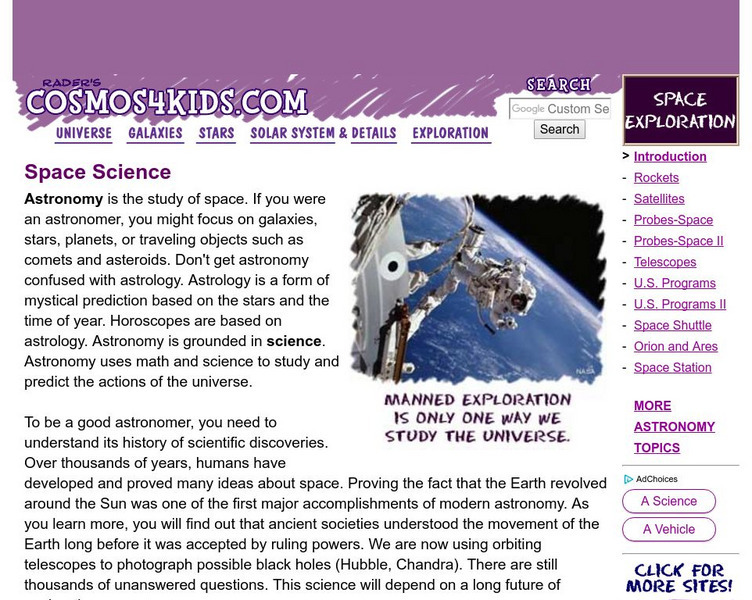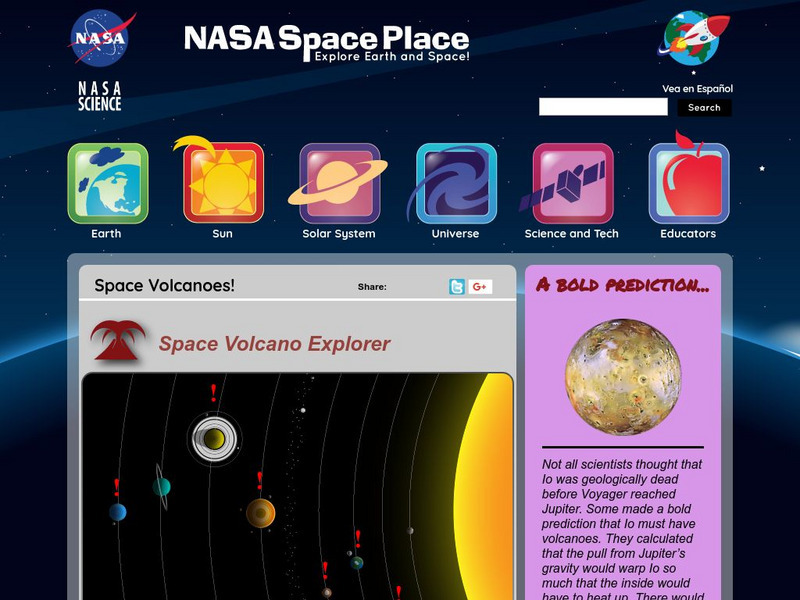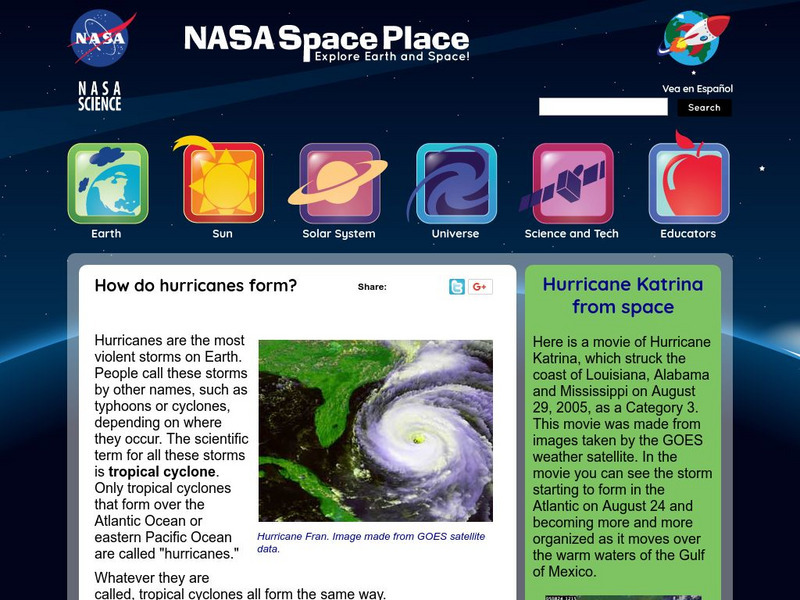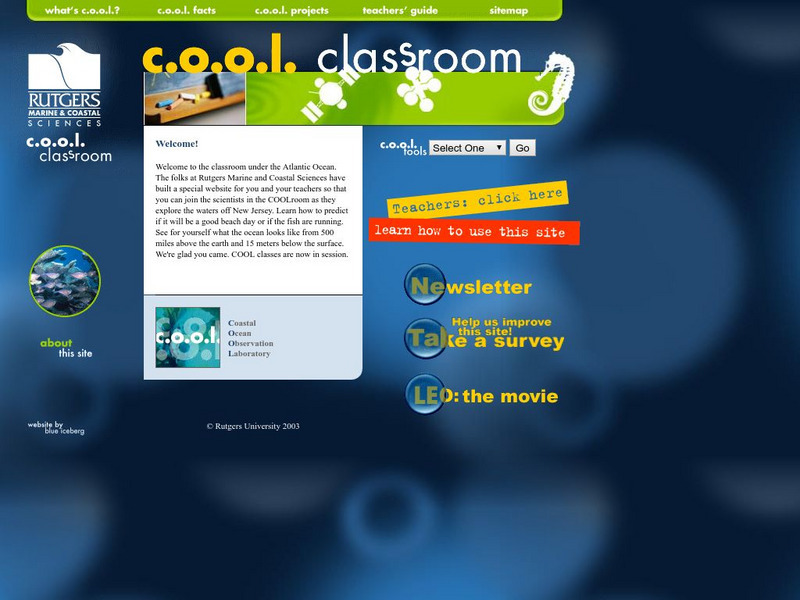Other
The Space Race
Although the space race was originally a competition between two Cold War foes,it ultimately resulted in many benefits for the people of the Earth. Find information on the Mercury, Gemini, and Apollo, and Soviet space programs,...
Smithsonian Institution
National Air and Space Museum: Exploring the Planets: Tools of Exploration
Part of the National Air and Space Museum's online exhibition about Exploring Planets, this describes and gives visuals of telescopes, probes and fly-by aircrafts, orbiters, and landers as current methods for earth and airborne...
Smithsonian Institution
National Air and Space Museum: Exploring the Planets: Early Discovery
This section of the exhibition gives the history of the discovery and study of space starting with the Greeks and Romans through to the early 1900's.
Cosmos 4 kids
Cosmos4 kids.com: Exploration
Space can be explored in many different ways. Read about space exploration and click on the topics on the right margin to find out how man finds out about his universe.
NASA
Nasa: 1nd Century Explorer: How Would Your Body Change in Space?
This article explores the changes an astronaut's body goes through in space. Also find the answer to many other fascinating questions people have about space travel.
Library of Virginia
Virginia Memory: Blank Space: Mapping the Unknown
How did early maps show the mapmakers' perception of the known world? Early mapmakers used maps drawn from coastal explorations, land travels, and even information heard word of mouth from American Indians or from colonists or traders....
NASA
Nasa: The Space Place: Why Is the Sky Blue?
Learn about colors of light by exploring how prisms work. Discover the different colors of the spectrum and how the visible light is what we see.
Other
Lunar and Planetary Institute: Explore! Mars Inside and Out
Four hands-on activities and explorations designed to engage children in learning about Mars.
NASA
Nasa: Space Place: Space Volcanoes!
Click and explore the solar system to discover where volcanoes can be found, on planets and moons.
Alabama Learning Exchange
Alex: Can Plants Be Grown in Space?
This lesson allows students to explore finding a solution to growing plants in space. Students will have the opportunity to conduct a scientific investigation to discover if plants can grow in space. Students will also take a virtual...
Space Telescope Science Institute
Amazing Space: Galaxy Hunter
Journey to the wildest regions of space, and wrestle with cosmic giants, galaxies. Explore the Hubble Deep Fields from a statistical point of view.
Other
Everytrail: Trail Map of San Andreas Fault Trail Exploration
Use this map on the San Andreas Fault by following lines of posts that mark the various fault breaks in the Los Trancos Open Space Preserve. The trail takes hikers to see some of the effects of earthquakes in this otherwise tranquil...
Smithsonian Institution
National Air and Space Museum: Exploring the Planets: Mercury
This is a useful resource for facts and images pertaining to the planet Mercury.
NASA
Nasa Space Place: Sun
Test your knowledge about the sun with games and activities designed to help explore what you know.
Smithsonian Institution
National Air and Space Museum: Exploring the Planets: Ancient Times & the Greeks
In ancient times only five planets were known: Mercury, Venus, Mars, Jupiter, and Saturn. Learn about Greek astronomer Ptolemy's theory for the solar system that was to survive for fourteen centuries.
NASA
Nasa: Space Place: Explore Mars: A Mars Rover Game
Drive a rover on Mars and collect information about Martian rocks.
Smithsonian Institution
National Air and Space Museum: Exploring the Planets: Earth's Lithosphere
The plate tectonics and other features of the Earth's lithosphere are explained and illustrated. Has links to definitions of the magnetosphere, atmosphere, and hydrosphere.
Cosmos 4 kids
Cosmos4 Kids: Exploration: Rockets
The entire history of rocketry took place in 100 years! The early 1900's saw their first appearance, and by the end of the century, rocket technology took many forms with the most famous being the Space Shuttle. The brief, to the point...
NASA
Nasa: The Space Place: How Do Hurricanes Form?
This resource explores how hurricanes form and why they are called tropical cyclones. Images and illustrations are provided supporting this information.
PBS
Pbs Teachers: Scientific American: Journey to Mars: Getting There
Explore the usefulness of space probes by comparing an unmanned probe's accuracy with human observation. Design a planet surface with varied features, and then create probes to discover features of the planet's surface.
American Museum of Natural History
American Museum of Natural History: Piloting Red Rover
Do you have what it takes to drives a robot on Mars?
Cosmos 4 kids
Cosmos4 Kids: Solar System Details: Oort Cloud
Explore the huge spherical region surrounding our solar system. Find out what the Oort Cloud contains and how comets originate there.
NASA
Nasa Space Place: The Mars Rovers
Learn why rovers are important and details about the Sojourner, Spirit, Opportunity, Curiosity, and Perseverance.
Other
Rutgers Marine & Coastal Sciences: Cool Classroom
Students and teachers can explore the work of marine scientists and observe the ocean from their computers. Learn about Rutgers Coastal Ocean Observation Laboratory, discover why oceanography is important, and see what life is like in...


















